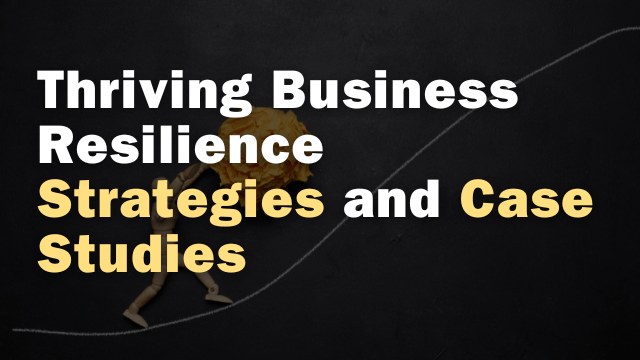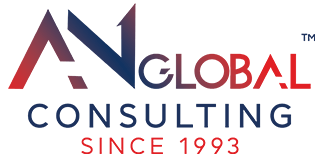
Table of Contents
In today’s rapidly changing business landscape, the concept of business resilience has become more crucial than ever. Organizations face various challenges, from economic downturns to natural disasters, and cybersecurity threats to global pandemics. To thrive in such unpredictable environments, businesses must adopt robust resilience strategies and learn from real-world examples. In this blog post, we’ll explore the concept of business resilience, delve into effective strategies for enhancing resilience, and examine a compelling business continuity plan case study.
Understanding Business Resilience
Business resilience refers to an organization’s ability to adapt and thrive in the face of disruptions, ensuring continuity of operations and the ability to bounce back from adversity. It encompasses a proactive approach to identifying risks, implementing mitigation measures, and building adaptive capabilities. Rather than merely reacting to crises, resilient businesses anticipate and prepare for potential challenges, enabling them to maintain stability and recover quickly when disruptions occur.
Let’s delve into a real-life example of business resilience
During the global financial crisis of 2008, Starbucks Corporation demonstrated remarkable resilience in navigating the turbulent economic environment and emerging stronger than ever.
Background
Starbucks, a leading global coffeehouse chain, faced significant challenges during the financial crisis, including declining consumer spending, reduced foot traffic, and intense competition in the coffee market. Despite these headwinds, Starbucks remained committed to its core values and customer-centric approach.
Resilience Strategies
1. Diversification of Offerings: Recognizing the impact of economic uncertainty on consumer behaviour, Starbucks expanded its product offerings beyond coffee to include food items, branded merchandise, and loyalty programs. This diversification helped mitigate the decline in coffee sales and drive incremental revenue streams.
2. Cost Optimization: In response to tightening consumer budgets, Starbucks implemented cost-saving measures across its operations, including streamlining menu offerings, optimizing store layouts, and renegotiating supplier contracts. These initiatives enabled Starbucks to maintain profitability while offering value to customers.
3. Focus on Customer Experience: Despite economic challenges, Starbucks remained committed to delivering exceptional customer experiences across its stores. The company continued to invest in employee training, store ambience, and digital innovation to enhance customer satisfaction and loyalty.
4. Global Expansion and Market Penetration: Rather than retreating in the face of adversity, Starbucks pursued aggressive expansion strategies in emerging markets, such as China and India. By capitalizing on growing consumer demand for premium coffee experiences, Starbucks diversified its geographic footprint and reduced reliance on mature markets.
5. Sustainability and Corporate Social Responsibility: Starbucks doubled down on its commitment to sustainability and corporate social responsibility initiatives, including ethical sourcing, environmental stewardship, and community engagement. These efforts resonated with socially conscious consumers and reinforced Starbucks’ brand reputation during challenging times.
Outcomes
Despite the economic downturn, Starbucks emerged from the financial crisis as a stronger and more resilient company:
– Financial Performance: Starbucks’ strategic initiatives, including diversification, cost optimization, and global expansion, contributed to sustained revenue growth and improved profitability.
– Brand Resilience: By maintaining a focus on customer experience and corporate values, Starbucks reinforced its brand resilience and retained customer loyalty even in the face of economic uncertainty.
– Long-Term Growth Trajectory: Starbucks’ investments in sustainability, innovation, and global expansion positioned the company for long-term growth and resilience beyond the financial crisis.
Starbucks’ resilience during the 2008 financial crisis serves as a compelling example of how strategic foresight, customer-centricity, and adaptability can enable businesses to weather storms and emerge stronger from adversity. By leveraging diversification, cost optimization, customer experience, global expansion, and sustainability, Starbucks navigated the challenges of the financial crisis and continued its trajectory of growth and success.
This example illustrates how resilience strategies can help businesses not only survive but thrive in challenging environments, reinforcing the importance of agility, innovation, and a steadfast commitment to core values.
With AN GLOBAL CONSULTING, businesses can access expert guidance and support to implement resilience strategies effectively. Offering comprehensive services ranging from business planning and franchise development to strategic growth initiatives, AN GLOBAL CONSULTING combines industry expertise with innovative solutions to help businesses thrive
in uncertain times. With a focus on customer-centricity and adaptability, AN GLOBAL CONSULTING empowers businesses to navigate challenges, capitalize on opportunities, and achieve sustained success in today’s dynamic market landscape.
Strategies for Business Resilience
1. Risk Assessment and Mitigation: The first step in building resilience is conducting a comprehensive risk assessment to identify potential threats and vulnerabilities. This includes analysing internal and external factors that could impact the business, such as market volatility, supply chain disruptions, and regulatory changes. Once risks are identified, businesses can develop mitigation strategies to minimize their impact.
2. Diversification and Redundancy: A key aspect of resilience is diversifying operations and building redundancy into critical systems and processes. This involves spreading risk across multiple markets, suppliers, and locations to reduce dependency on any single point of failure. By diversifying revenue streams and investing in redundant infrastructure, businesses can enhance their ability to withstand disruptions.
3. Adaptive Planning and Flexibility: Business continuity planning is essential for resilience, but plans must be dynamic and adaptable to changing circumstances. Rather than relying on rigid frameworks, businesses should adopt agile planning processes that allow for rapid response and adjustment. This includes establishing clear communication channels, delegating decision-making authority, and regularly testing and updating continuity plans.
4. Investment in Technology and Innovation: Embracing technology and innovation can significantly enhance resilience by improving operational efficiency, agility, and adaptability. Businesses should invest in digital transformation initiatives like cloud computing, data analytics, and automation to streamline processes and enable remote work capabilities. Additionally, leveraging emerging technologies like artificial intelligence and the Internet of Things can provide valuable insights and predictive capabilities to anticipate and mitigate risks.
5. Stakeholder Engagement and Collaboration: Collaboration is key to resilience, as businesses cannot overcome challenges in isolation. Engaging with stakeholders, including employees, customers, suppliers, and community partners, fosters trust, transparency, and collective problem-solving. By building strong relationships and networks, businesses can access additional resources, expertise, and support during times of crisis.
Business Continuity Plan Case Study
Amidst the unprecedented challenges brought about by the COVID-19 pandemic, businesses worldwide were forced to adapt rapidly to ensure continuity of operations while safeguarding the health and well-being of their employees. In this case study, we’ll delve into how Company X, a global manufacturing firm specializing in automotive components, effectively activated its business continuity plan to navigate the complexities of the pandemic.
Company Overview
Company X is a renowned manufacturer of automotive components, with operations spanning multiple countries and a diverse portfolio of clients. With a commitment to quality, innovation, and customer satisfaction, Company X has established itself as a leader in the industry.
Challenges Faced
As the COVID-19 pandemic spread rapidly across the globe, Company X faced a myriad of challenges that threatened its operations:
1. Safety Concerns: Ensuring the health and safety of employees became paramount, with the risk of virus transmission looming large in manufacturing facilities and office spaces.
2. Supply Chain Disruptions: The pandemic disrupted supply chains, causing delays in the procurement of raw materials and components essential for production.
3. Market Uncertainty: Economic uncertainty and fluctuating demand pose challenges in forecasting and planning, impacting production schedules and revenue projections.
Activation of Business Continuity Plan
Recognizing the need for a swift and coordinated response, Company X activated its business continuity plan, which had been developed and tested as part of its risk management strategy. Key elements of the plan included:
1. Employee Safety Protocols: Company X implemented rigorous safety protocols by public health guidelines, including temperature checks, social distancing measures, and the provision of personal protective equipment (PPE) to all employees.
2. Remote Work Arrangements: Where feasible, Company X transitioned non-essential employees to remote work arrangements to minimize the risk of virus transmission while ensuring business continuity.
3. Supply Chain Diversification: To mitigate the impact of supply chain disruptions, Company X diversified its supplier base and established alternative sourcing options, reducing dependency on single suppliers and regions.
4. Production Optimization: Company X optimized production processes to adapt to changing demand patterns and ensure efficient utilization of resources. This involved prioritizing high-demand products, adjusting production schedules, and implementing lean manufacturing principles.
5. Communication and Collaboration: Clear and transparent communication channels were established to keep employees informed of developments, expectations, and support resources available. Collaboration with suppliers, customers, and industry partners facilitated shared solutions and mutual support during challenging times.
Outcomes and Lessons Learned
Through the effective implementation of its business continuity plan, Company X was able to navigate the challenges posed by the COVID-19 pandemic and emerge resilient:
1. Continuity of Operations: Despite the disruptions caused by the pandemic, Company X maintained operational continuity, fulfilling customer orders and meeting contractual obligations.
2. Employee Well-Being: The prioritization of employee safety and well-being fostered a sense of trust and loyalty among employees, enhancing morale and productivity.
3. Adaptability and Agility: Company X demonstrated adaptability and agility in responding to evolving circumstances, leveraging technology and innovation to optimize operations and meet changing customer needs.
4. Supply Chain Resilience: The diversification of the supply chain proved invaluable in mitigating the impact of disruptions, ensuring a steady flow of materials and components essential for production.
5. Preparedness for Future Challenges: The experience gained from navigating the pandemic reinforced Company X’s commitment to risk management and business resilience, providing valuable insights and lessons learned for future challenges.
The case of Company X exemplifies the importance of proactive planning, effective execution, and adaptability in ensuring business resilience in the face of crises. By activating its business continuity plan and prioritizing employee safety, supply chain resilience, and operational agility, Company X not only weathered the storm of the COVID-19 pandemic but emerged stronger and better prepared for future challenges.
In navigating the complexities of business resilience, partnering with a trusted advisor can make all the difference. AN Global Consulting stands out as the premier choice for comprehensive business guidance, franchise support, and sustainable growth strategies.
With a proven track record of empowering companies to thrive in uncertain times, AN Global Consulting offers tailored solutions that prioritize proactive planning, operational efficiency, and strategic adaptation. Whether it’s navigating crises, expanding into new markets, or optimizing business processes, AN Global Consulting is your trusted partner for resilience and growth.
Key elements of Company X’s resilience strategy included
– Remote Work Readiness: Company X had previously invested in technology infrastructure and remote work capabilities, enabling employees to transition seamlessly to remote work arrangements.
– Supply Chain Diversification: Recognizing the potential impact of supply chain disruptions, Company X diversified its supplier base and established alternative sourcing options.
– Employee Support and Communication: Company X prioritized employee well-being by providing support services, such as mental health resources and flexible work arrangements. Clear and transparent communication channels were established to keep employees informed of developments and expectations.
– Agile Decision-Making: Company X’s leadership team demonstrated agility and decisiveness in navigating the crisis, making data-driven decisions and adjusting strategies to address evolving challenges.
– Community Engagement: Company X collaborated with local authorities, healthcare providers, and community organizations to support pandemic response efforts and contribute to the broader community’s resilience.
As a result of these proactive measures, Company X was able to maintain business continuity, safeguard its workforce, and emerge stronger from the crisis.
The Ongoing Journey of Building Business Resilience
Building business resilience is not a one-time effort but an ongoing journey that requires proactive planning, strategic investment, and a culture of adaptability. By implementing robust resilience strategies and learning from real-world case studies, businesses can enhance their ability to withstand disruptions, thrive in uncertainty, and emerge stronger in the face of adversity.
At AN Global Consulting, we understand the intricacies of building business resilience and offer tailored solutions to support your journey. With expertise in business guidance, franchise development, and fostering sustainable growth, we provide comprehensive support to help businesses thrive amidst uncertainty.
Partner with us to leverage our insights, strategies, and industry experience, empowering you to navigate challenges effectively and emerge stronger than ever.


